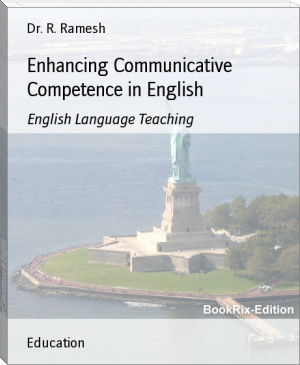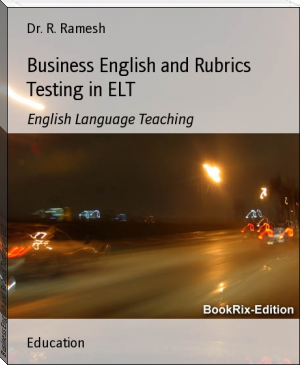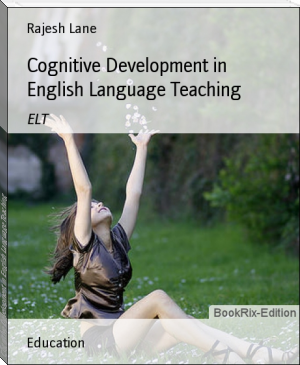Communicative Competence in English by Dr. R. Ramesh (best ereader manga TXT) 📖

- Author: Dr. R. Ramesh
Book online «Communicative Competence in English by Dr. R. Ramesh (best ereader manga TXT) 📖». Author Dr. R. Ramesh
English education has been a part of our educational system for more than a century. Yet it is beyond the reach of most of our youngsters. Free and compulsory education up to high school increased the literacy rate in our country. Educated youngsters are reluctant to do their traditional jobs and aim at white collar jobs. Thus there is a great competition among our youngsters in the job market. They are well versed in their subjects but are unable to express their knowledge in English.
Though we have a long tradition of English language teaching, we fail impart it successfully. Some reasons for failures are, 1. Aversion towards English rulers. 2. Lack of specific objectives and aims 3. Implementation of defective methods of teaching. 4. Defective curriculum 5. Different policies taken by British government 6. Policies of state government 7. Inadequate material 8. Faulty system of examination 9. Lack of clear cut policy 10. Crowded classrooms and shortage of time 11. Socio political problems 12. Lack of motivation among learners 13. Lack of communicative need
It is high time to change our attitude towards English language learning and teaching. As it remains an important link language between states and countries we need to use English in our day to day life. A person who can handle English at ease can manage anywhere in the world.
The selected area for the study is Tirunelveli district, which is a fastest growing city in South India. Some major industrial operations are undergoing in this city. The state and central government have agreed to set up Information Technology Park in this district and Indian government has approved Nanguneri as a Special Economic Zone (SEZ) for the promotion of electronic, telecom, manufacture of white goods and computer hardware, entertainment electronics, software development, agro based industries, food processing and precision engineering industries. Chief promoters of this project are INFAC India Group, USA and Axes Technologies Inc, USA. Many industrialist and entrepreneurs have been invited for Foreign Direct Investment (FDI). ATMAC Ltd, JTC Singapore and Jurong International Singapore have submitted their master plan for building industrial sector, which include ready built factories, custom built factories, unit of multinational corporations, science, business and hi-tech information technology parks. When this schemes are in full fledged operation it is expected to provide a colossal opportunity for about one lakh jobs directly and two lakhs jobs indirectly in Tirunelveli district and the adjoining district such as Tuticorin, Nagercoil , Virudunagar and Madurai.
Another important industrial development in this district is Software Technology Park of India in Tirunelveli district which is situated in Vasanthpuram-Tirunelveli bypass road. This STPI is one of the international gateways of STPI Chennai. Tamil Nadu Government has chosen SIPCOT industrial complex at Gangaikondan on the Tirunelveli-Madurai highway for the expansion of this IT Park. This multi crore project IT Park will provide jobs to a minimum of 10,000 skilled workers in the first phase itself. The staff reporter of the The Hindu gives an article entitled ‘Industrial Park at Gangaikondan’ reported that
The ELCOT M.D appealed to the Vice Chancellor of Manonmaniam Sundaranar University to start more courses on information technology and computer science in the university and the affiliated colleges to churn out skilled work force with excellent communicative skills in English in the next five years. Even plus two students with superior knowledge in English are being recruited by B.P.O companies with an attractive salary. Hence it as imperative that, the skilled workforce should have high degree of communication skill to impress the foreign companies. (1)
Recently TATA groups have signed a significant project of Titanium Dioxide Plant for Rs. 2500 crore in Tirunelveli and Tuticorin district. This project will create a job opportunity for 1000 persons directly and 3000 indirectly.
Nuclear Power Project at Kudankulam which expands Radhapuram Taluk in Tirunelveli and Tuvarikulam in Tuticorin districts also provide wide opportunity for our skilled youths.
All these national, international and multinational companies need graduates who are sound in their subjects as well as in their communication skills. So it is the duty of the educational institutions to equip our learners to meet the future needs of industries and the corporate sectors.
National Knowledge Commission 2006 (NKC) also recommend to establish 1500 universities to meet out the higher education needs of learners in our country. Now India has around 350 universities. To attain this goal, they suggested to invite foreign and NRI investment in the field education. This atmosphere will also create innumerable opportunities for academic non-academic and skilled professionals. At this juncture it is relevant to conduct a study on the present topic.
VIII. Methodology of Research
Interviews, observation and interaction with the learners and teachers are the methods used for entering the entry behavior of the current situation for the present study. For this the researcher has met the learners once in a week continuously for six months.
IX. Methodological Tools Methodological Tools used for this study are Situational Activities, Role Play, Brain-Storming Sessions, Group Discussion, Simulation, Public Speaking, Interviews, Problem Solving, Dialogue Writing, Personality Development, etc.
The existing scenario demands brighter communication skills in English to reach out the international customers as well as people from various walks of life. With an aim of developing the communication skills in English, the researcher has decided to use learner-centered activities to train the non-major post graduate students of Manonmaniam Sundaranar University. The highest degree of attaining communicative competence in English can be achieved through the learner–centered activities that are to be practiced in the class room. It has no doubt that the learners will definitely being interested in participating the activities as it gives no pain to the learners. The unique approach of developing communicative English at the P. G. level can never go without fetching the favorable result.
CHAPTER – II
COMMUNICATIVE ENGLISH LANGUAGE TEACHING AND OTHER METHODS
I.A Brief History of Language Teaching
Today, English occupies a significant position among the world’s most widely studied languages. Almost five hundred years ago, it was Latin which enjoyed the position of dominant language of education, commerce, religion and government in the Western world. In sixteenth century, after the political changes in Europe, Latin was gradually displaced by French, Italian and English. Latin got diminished from a position of ‘living language’ to a position of ‘occasional’ subject in the school curriculum. Methods used to teach classical Latin were adopted for teaching modern languages in the seventeenth and eighteenth centuries.
By eighteenth century, modern languages began to enter in the school curriculum of Europe. They were taught on the same way how Latin was taught. They neglected oral proficiency of the language and gave training in grammar rules, vocabulary building, reading aloud and translation. By nineteenth century, this ‘Latin model’ of teaching became a standard way of teaching foreign languages in schools. Nineteenth century text book compilers tried to codify foreign language into frozen rules of morphology and syntax. They provided explanations along with rules and learners were forced to memorize these rules. Oral works were reduced to a minimum. A modified version of this approach to foreign language teaching became known as Grammar-Translation Method.
The Grammar-Translation Method
Johann Seidenstrucker, Karl Plotz, H.S. Ollendorf and Johann Meidinger are the major exponents of Grammar-Translation Method. This method was treated as an “offspring of German scholarship” (Richard and Rogers 3). In United States, this method was known as ‘Prussian Method’.
Major characteristics of Grammar-Translation Methods are, 1. First language is treated as the reference system for the learning of second Language. 2. Focus on reading and writing skills. 3. Vocabulary taught through bilingual approach. 4. Translation of sentences into and out of the target language. 5. Focus on accuracy and high standard in translation. 6. Grammar taught deductively. 7. Learner’s native language is the medium of instruction.
Grammar-Translation method dominated European foreign language teaching from 1840s to 1940s. During mid-nineteenth century, many opposed Grammar-Translation Method. This reform movement laid the foundation for the development of new ways of teaching language.
Language Teaching Innovations in the Nineteenth Century
Increased opportunity for communication among Europeans and other foreign language speakers created a demand for oral proficiency in foreign languages. Many “language teaching specialists turned their attention to the way modern languages were being taught in secondary schools.” (Richard and Rogers 5). Individual language teaching specialists like C.Marcel, T.Prendergast and F.Gouin had developed some specific methods for reforming the teaching of modern languages. However they have failed in their attempt to create a lasting effect in the history of language teaching tradition.
Reform movement in Language Teaching:
Marcel, Prendergast and Gouin had done much to promote foreign language teaching. They failed in their attempt because; of lack of wide spread attention, support and proper leadership. In 1880s, practical minded linguists like Henry Sweet in England, Wilhem Vietor in Germany and Paul Passy in France began to provide intellectual leadership. They emphasized speech as the primary form of language, rather than written words.
In 1886, International Phonetic Association (IPA) was formed and they have designed International Phonetic Alphabet (IPA) to help the learners to transcribe the sound of any language accurately. Henry Sweet, a well known linguist argued for sound methodological principles of language teaching which should be based on the scientific analysis of language and a study of psychology. He set forth principles for the development of teaching methods in his work The Practical Study of Languages (1899).
They are 1) Careful selection of what is to be taught. 2) Imposing limits on what is to be taught. 3) Arranging what is to be taught in terms of four skills of listening, speaking, reading and writing. 4) Grading materials from simple to complex. (Richards and Rogers 7).
Late nineteenth century reformers shared theirs views about the principles of language teaching. They believed that, 1. Spoken language proficiency can be attained through oral based methodology. 2. Phonetic principles should be applied to teaching and teacher training. 3. Listening follows writing. 4. Words should be presented in sentences through meaningful contexts. 5. Rules of grammar should be taught inductively. 6. Translation should be avoided and mother tongue could be used to explain new words or to check comprehension. These principles provided a good theoretical foundation for different approaches to language teaching.
These reform movements created interest in the development of principles of language teaching and learning. These principles are derived from the rules of first language acquisition which led to the development of Natural Method and Direct Method.
Direct Method
Gouin, one of the nineteenth century reformers had attempted to develop a methodology, which was based on his observation of child language learning. During the late nineteenth century, other reformers were also concentrated on the naturalistic principles of language learning. L. Sauveur proposed a new method which aimed at intensive oral interactions in the target language by employing questions for presenting and eliciting language. His method was known as Natural Method. Direct Method, one of the widely used methods in foreign language teaching came under this Natural Method. Major principles of Direct Method include; 1. Classroom instruction in the target language. 2. Vocabulary and sentences were taught regularly. 3. Oral communication skills were built up in a carefully graded progression. 4. Grammar taught inductively. 5. New teaching points introduced orally. 6. Concrete vocabulary was taught by using objects and pictures and abstract vocabulary by association of ideas. 7. Speech and listening comprehension were taught in the class. 8. More emphasis given to pronunciation and correct usage of grammar.
This method was successful in private language schools. Though
 The desire to acquire knowledge about the surrounding world and human society is quite natural and understandable for a person. Life is so developed that an uneducated person will never occupy a high position in any field. Humanity in its mass, and each person individually, develops objectively, regardless of certain life circumstances and obstacles, but with different intensity. The speed of development depends on the quality of training.
The desire to acquire knowledge about the surrounding world and human society is quite natural and understandable for a person. Life is so developed that an uneducated person will never occupy a high position in any field. Humanity in its mass, and each person individually, develops objectively, regardless of certain life circumstances and obstacles, but with different intensity. The speed of development depends on the quality of training.




Comments (0)